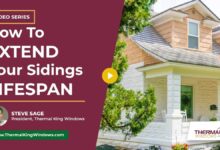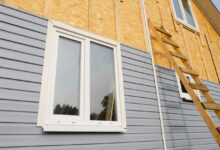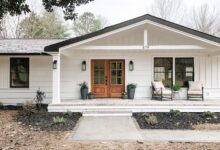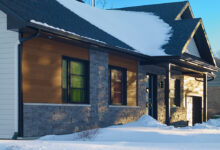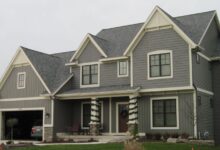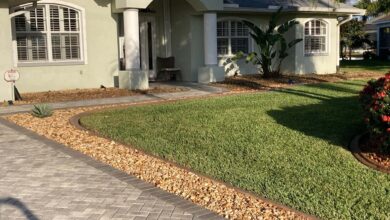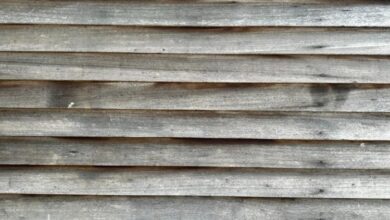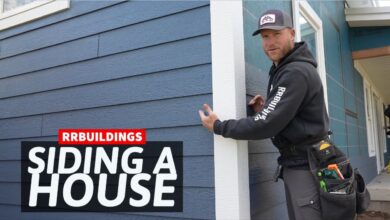Affordable Alternatives to Natural Wood Siding
Affordable Alternatives to Natural Wood Siding offer a compelling solution for homeowners seeking durable, aesthetically pleasing exterior cladding without the high cost of natural wood. This exploration delves into various cost-effective options, examining their properties, applications, and long-term implications, empowering you to make informed decisions for your home improvement projects.
From the environmentally conscious appeal of recycled materials to the low-maintenance practicality of vinyl and the robust longevity of fiber cement, we’ll navigate the diverse landscape of affordable siding alternatives. We’ll compare durability, maintenance needs, and aesthetic versatility, providing a comprehensive overview to assist in your selection process.
Introduction to Affordable Siding Materials
Natural wood siding offers undeniable aesthetic appeal, but its cost and maintenance requirements can be prohibitive for many homeowners. Fortunately, a range of affordable alternatives provide comparable visual effects with reduced expense and upkeep. These materials vary in their properties, offering a diverse selection to suit different budgets and architectural styles. Choosing the right alternative depends on factors such as climate, desired aesthetic, and the homeowner’s DIY capabilities.
This section explores several cost-effective siding materials, comparing their pricing to natural wood and showcasing their successful implementation in various architectural designs. We will examine their longevity, maintenance needs, and overall value proposition.
Vinyl Siding
Vinyl siding is a popular and widely accessible alternative to wood. Its affordability stems from its mass production and ease of installation. Typically costing significantly less than wood siding – often 30-50% less depending on the quality and style – vinyl offers a wide range of colors and textures mimicking the look of wood, brick, or stone. Its low maintenance needs, resistance to rot and insect infestation, and long lifespan contribute to its cost-effectiveness over the long term. Examples of successful applications include suburban homes, where its versatility allows it to complement various architectural styles, from traditional Cape Cods to modern ranch houses. The consistent color and low maintenance make it particularly suitable for large-scale projects.
Fiber Cement Siding
Fiber cement siding combines cement, cellulose fibers, and other additives to create a durable and fire-resistant material. While more expensive than vinyl, it is generally less costly than natural wood siding, offering a mid-range price point. Its strength and longevity mean less frequent replacement, offsetting the higher initial investment. Fiber cement siding effectively mimics the look of wood clapboard or shingles, providing a sophisticated and natural aesthetic. It is often seen on homes seeking a more upscale look without the premium cost of real wood. For instance, a craftsman-style home featuring fiber cement siding can achieve a refined appearance while remaining budget-conscious.
Engineered Wood Siding
Engineered wood siding, such as composite wood siding, is created by combining wood fibers with resins and other binding agents. This process yields a product more resistant to moisture damage and insect infestation than solid wood. The cost is usually lower than solid wood, but higher than vinyl. It offers a variety of textures and colors, often mimicking the appearance of natural wood grains. This makes it suitable for a variety of architectural styles, from rustic cabins to contemporary homes. The durability and relative affordability make it a good compromise between cost and aesthetic appeal. A modern farmhouse design might effectively utilize engineered wood siding to achieve a rustic charm at a moderate price.
Fiber Cement Siding
Fiber cement siding offers a durable and attractive alternative to natural wood, providing homeowners with a cost-effective solution that mimics the aesthetic appeal of wood without the high maintenance demands. Its composition, manufacturing process, and performance characteristics contribute to its growing popularity as a preferred exterior cladding material.
Fiber cement siding is a composite material, engineered for strength and longevity. The manufacturing process involves combining Portland cement, cellulose fibers (often from recycled paper), and silica sand. These ingredients are mixed with water, creating a slurry that is then formed into the desired shapes and sizes – typically planks or panels – using specialized molding techniques. After molding, the material undergoes a high-pressure steaming process to cure and harden the mixture. Finally, the cured siding undergoes a finishing process, often involving painting or texturing to enhance its aesthetic appeal and protect against the elements. The precise formulation and manufacturing process can vary slightly between manufacturers, resulting in some differences in the final product’s properties.
Durability and Lifespan of Fiber Cement Siding Compared to Wood
Fiber cement siding significantly surpasses natural wood in terms of durability and lifespan. Wood siding is susceptible to rot, insect infestation (termites, carpenter ants), and warping due to moisture fluctuations. It also requires regular painting or staining to maintain its appearance and protect it from the elements. Fiber cement, on the other hand, is inherently resistant to rot, insects, and fire. Its non-combustible nature makes it a safer option than wood, especially in areas prone to wildfires. While fiber cement siding can be damaged by severe impacts, its overall resilience to weathering and degradation leads to a much longer lifespan, typically exceeding 50 years, compared to the 15-25 year lifespan often seen with properly maintained wood siding. This longer lifespan translates to significant long-term cost savings, offsetting the potentially higher initial investment.
Maintenance Requirements of Fiber Cement and Wood Siding
The following table compares the maintenance needs of fiber cement and wood siding:
| Feature | Fiber Cement Siding | Wood Siding |
|---|---|---|
| Painting/Staining | Typically requires repainting every 15-20 years, depending on climate and exposure. | Requires repainting or restaining every 3-5 years, depending on climate and exposure, and type of finish. |
| Cleaning | Regular cleaning with water and a soft brush removes dirt and debris. | Requires more frequent cleaning to remove dirt, mildew, and insect debris. |
| Repair | Damage is usually localized and relatively easy to repair with patching compounds. | Repairing rot, insect damage, or warping can be complex and costly. |
| Pest Control | No preventative pest control is needed. | Regular pest inspections and treatments may be required. |
Vinyl Siding
Vinyl siding presents a budget-friendly alternative to natural wood, offering a range of aesthetic choices and relatively low maintenance. Its popularity stems from its affordability and ease of installation, making it a viable option for homeowners seeking a cost-effective exterior cladding solution.
Vinyl siding’s versatility in mimicking the look of other materials, such as wood, brick, or stone, is a significant advantage. Manufacturers offer a wide variety of colors, textures, and profiles, allowing homeowners to achieve a desired aesthetic without the expense and upkeep associated with natural materials. For instance, vinyl siding can be designed to replicate the appearance of clapboard, shingle, or even stucco, offering a level of customization that appeals to diverse architectural styles. This adaptability extends beyond simple visual imitation; subtle variations in texture and color can significantly influence the overall impression of a home’s exterior.
Aesthetic Versatility of Vinyl Siding
The broad spectrum of styles and colors available in vinyl siding allows for considerable creative freedom in home exterior design. Modern manufacturing techniques enable the production of vinyl siding that convincingly replicates the appearance of high-end materials, such as cedar shake or stone, at a fraction of the cost. Furthermore, the availability of different profiles and panel sizes allows for the creation of varied and visually interesting facades, catering to both traditional and contemporary architectural tastes. The use of accent pieces and trim in contrasting colors or textures further enhances the design possibilities.
Impact of Weather Conditions on Vinyl Siding Longevity
While vinyl siding is generally durable and weather-resistant, extreme weather conditions can affect its lifespan. Prolonged exposure to intense sunlight can lead to fading or discoloration, especially in darker colors. Similarly, extremely cold temperatures can cause the vinyl to become brittle and more susceptible to cracking. Conversely, excessive heat can cause expansion and potential warping. Regular cleaning and maintenance, such as removing debris and addressing any minor damage promptly, can help mitigate the impact of harsh weather and prolong the life of the siding. For example, a home situated in a desert climate might experience more rapid fading than one in a temperate zone, highlighting the importance of considering regional weather patterns when selecting vinyl siding and planning for maintenance.
Pros and Cons of Vinyl Siding
The decision to use vinyl siding involves weighing its advantages against its limitations. Below is a summary of the key pros and cons:
- Pros:
- Affordable: Vinyl siding is significantly cheaper than wood siding, reducing overall construction costs.
- Low Maintenance: It requires minimal upkeep, typically needing only occasional cleaning.
- Durable: Vinyl is resistant to rot, insect infestation, and moisture damage.
- Versatile: A wide range of colors, textures, and styles are available to match various aesthetics.
- Easy Installation: Vinyl siding is relatively quick and easy to install, reducing labor costs.
- Cons:
- Susceptible to damage from impact: Strong impacts can dent or crack the vinyl.
- Can fade or discolor over time, particularly with prolonged sun exposure.
- Less environmentally friendly than some other materials due to its petroleum-based composition.
- May not be as aesthetically pleasing to some as natural wood siding.
- Expansion and contraction with temperature changes can lead to minor warping in extreme climates.
Engineered Wood Siding
Engineered wood siding offers a compelling alternative to both natural wood and other siding materials, providing a balance between cost-effectiveness and aesthetic appeal. It leverages the inherent strength and beauty of wood while mitigating some of the drawbacks associated with natural wood, such as susceptibility to moisture damage and warping. Several types of engineered wood siding are available, each with its own unique properties and performance characteristics.
Engineered wood siding is manufactured by combining wood fibers, resins, and other additives under high pressure and temperature. This process creates a composite material that is denser and more resistant to moisture and insects than natural wood. The resulting product boasts improved dimensional stability and durability, making it a suitable option for various climates and applications.
Types of Engineered Wood Siding
Several types of engineered wood siding are available, each with slightly different compositions and resulting properties. Common types include fiber cement siding (already discussed), wood-plastic composites (WPCs), and engineered wood planks treated with preservatives. WPCs, for instance, blend wood fibers with polymers, resulting in a material that is highly resistant to rot, decay, and insect infestation. Engineered wood planks, often made from smaller wood pieces glued together and treated with preservatives, offer a more traditional wood look but with improved durability.
Water Resistance and Fire Resistance of Engineered Wood Siding
Compared to natural wood, engineered wood siding generally exhibits superior water resistance. The manufacturing process creates a denser material with less porosity, reducing the absorption of moisture. This resistance to moisture ingress significantly minimizes the risk of rot, swelling, and warping, common problems with natural wood. However, the level of water resistance varies depending on the specific type of engineered wood and the quality of the manufacturing process. Proper installation, including appropriate flashing and sealing, is crucial to maximize water resistance for all siding types.
Regarding fire resistance, engineered wood siding typically offers comparable or slightly improved performance compared to natural wood. While it is still combustible, the added resins and manufacturing process can influence how it burns, potentially slowing the spread of flames. However, fire resistance ratings vary greatly depending on the specific product and its treatment. Always check the manufacturer’s specifications and relevant building codes for fire safety information.
Comparison of Engineered Wood Siding Options
| Siding Type | Water Resistance | Fire Resistance | Cost |
|---|---|---|---|
| Wood-Plastic Composite (WPC) | Excellent; resists rot and decay | Moderate; generally comparable to treated wood | Moderate to High |
| Engineered Wood Planks (Treated) | Good; improved over natural wood | Moderate; depends on treatment | Moderate |
| Fiber Cement Siding | Excellent; highly resistant to moisture | Excellent; non-combustible | High |
Metal Siding
Metal siding offers a durable and low-maintenance alternative to traditional wood siding, boasting a wide array of styles and colors to complement various architectural designs. Its longevity and resilience against the elements make it a strong contender in the affordable siding market, although initial costs might be higher than some alternatives.
Metal siding comes in various types, each with its own set of characteristics and price points. The choice of material significantly impacts both the aesthetic appeal and the long-term cost-effectiveness of the siding.
Types of Metal Siding Materials
The most common types of metal siding include aluminum, steel, and zinc. Aluminum siding is lightweight and relatively inexpensive, making it a popular choice for budget-conscious homeowners. However, it’s less durable than steel and can dent more easily. Steel siding, on the other hand, offers superior strength and longevity, resisting dents and damage more effectively. While initially more expensive than aluminum, its extended lifespan can offset this higher upfront cost. Zinc siding is a more premium option, known for its exceptional durability and attractive, naturally weathering patina. It’s the most expensive of the three but provides a unique aesthetic and extremely long lifespan.
Metal Siding Designs and Architectural Styles
Metal siding’s versatility allows it to seamlessly integrate into a variety of architectural styles. For example, a sleek, modern home might feature horizontal panels of aluminum siding in a neutral color, creating a clean and minimalist look. A more traditional home could utilize steel siding with a textured finish to mimic the appearance of wood clapboard. Zinc siding, with its unique weathering characteristics, is particularly well-suited to rustic or farmhouse styles, developing a rich, aged look over time. The variety of colors, finishes (such as smooth, textured, or embossed), and panel profiles available allows for significant design flexibility. One could even incorporate custom designs or patterns into the siding for a truly unique aesthetic.
Long-Term Cost Implications of Metal Siding
While the initial cost of metal siding might be higher than vinyl or engineered wood, its long-term cost-effectiveness often outweighs the initial investment. Metal siding is incredibly durable and requires minimal maintenance, unlike wood siding which needs regular painting and repairs. Its resistance to pests, rot, and fire also contributes to lower long-term costs. For example, a homeowner might spend significantly less on repairs and replacements over a 30-year period compared to a home with wood siding that requires frequent repainting and potential board replacements. This makes metal siding a potentially more affordable option in the long run, despite its higher upfront cost. The extended lifespan of metal siding – often exceeding 50 years – is a major factor contributing to its overall cost-effectiveness. Factors like the specific material chosen (aluminum, steel, or zinc), the chosen finish, and installation costs will ultimately influence the total cost. However, the reduced need for maintenance and repairs generally makes it a financially sound choice over the long term when compared to other materials with shorter lifespans.
Recycled Materials in Siding
The increasing awareness of environmental sustainability is driving a shift towards eco-friendly building materials, and siding is no exception. Recycled materials offer a compelling alternative to traditional siding options, presenting both environmental and potentially economic benefits. Exploring the use of recycled materials in siding reveals a promising avenue for sustainable construction.
Several siding materials incorporate recycled content, offering a tangible way to reduce waste and minimize the environmental impact of construction. These materials often leverage post-consumer or post-industrial recycled materials, diverting waste from landfills and reducing the demand for virgin resources. The resulting products can offer comparable performance to conventional siding while contributing to a greener building footprint.
Examples of Recycled Siding Materials
A variety of siding options now utilize recycled materials. For instance, some manufacturers produce recycled plastic siding, often incorporating polyethylene or PVC from post-consumer plastic waste such as bottles and packaging. Other examples include siding made from recycled wood fibers, often combined with other materials to enhance durability and weather resistance. Furthermore, some metal sidings utilize recycled aluminum or steel, reducing the need for mining new materials.
Environmental Benefits of Recycled Siding
The environmental advantages of using recycled materials in siding are substantial. The most significant benefit is the reduction of landfill waste. By incorporating recycled content, manufacturers decrease the demand for virgin materials, thereby conserving natural resources and reducing deforestation (in the case of wood-based recycled materials). The manufacturing process of recycled materials also often requires less energy than the production of virgin materials, contributing to lower greenhouse gas emissions. Finally, using recycled siding supports a circular economy model, promoting resource efficiency and reducing the overall environmental footprint of the building industry.
Cost and Availability of Recycled Siding
The cost and availability of recycled siding materials can vary significantly depending on the specific material, manufacturer, and geographic location. Generally, the price point may be comparable to or slightly higher than some conventional siding options, but the long-term environmental and potentially economic benefits need to be considered. Availability is also improving as the demand for sustainable building materials increases. While not as widely available as traditional siding in all regions, the market for recycled siding materials is steadily expanding, with more manufacturers incorporating recycled content into their product lines.
Installation Techniques for Affordable Siding
Installing affordable siding requires careful planning and execution to ensure a long-lasting, attractive, and weather-resistant exterior. Proper preparation and the use of appropriate tools are crucial for a successful installation, regardless of the siding material chosen. This section details the process for several popular affordable siding options.
Vinyl Siding Installation
Vinyl siding is known for its ease of installation, making it a popular DIY project. The process generally involves preparing the wall, installing starter strips, and then attaching the siding panels. Tools needed include a measuring tape, level, utility knife, circular saw (for cutting panels), and a nail gun. Proper underlayment, such as house wrap, is essential to protect against moisture damage. Before installing the siding, ensure the sheathing is properly prepared and any damaged areas are repaired. Vinyl siding panels interlock, creating a seamless and weathertight barrier. The panels are typically nailed into place, ensuring proper spacing for expansion and contraction.
Fiber Cement Siding Installation
Fiber cement siding is more durable than vinyl but requires more expertise for installation. The process is similar to vinyl, but the panels are heavier and require more precise cutting. Tools needed include a measuring tape, level, circular saw with a carbide-tipped blade (for accurate cuts), a drill with appropriate bits, and a nail gun capable of driving large-gauge nails. Underlayment is critical for fiber cement, as it is more susceptible to moisture damage than vinyl. Proper fastening is essential to prevent cracking or damage. Because of its weight and less forgiving nature, professional installation is often recommended.
Engineered Wood Siding Installation
Engineered wood siding offers a balance between cost and durability. Installation is similar to vinyl and fiber cement, but requires attention to proper sealing to prevent moisture absorption. Tools needed include a measuring tape, level, circular saw, nail gun, and caulking gun. A waterproof underlayment is crucial for engineered wood siding. The panels are typically nailed into place, and proper spacing is essential for expansion and contraction. Unlike vinyl, engineered wood siding often requires sealing around joints and edges to prevent water penetration.
Metal Siding Installation
Metal siding, often aluminum or steel, is highly durable and low-maintenance. Installation requires more specialized tools and expertise. Tools include a measuring tape, level, tin snips or shears, drill with appropriate bits, and rivets or screws. A metal underlayment is often used to prevent scratching and to provide a smooth surface for installation. Metal siding panels are typically overlapped and fastened securely to prevent wind damage. Proper sealing around edges and seams is essential to prevent water intrusion. Professional installation is frequently recommended due to the specialized tools and techniques involved.
Recycled Material Siding Installation
Recycled material siding, often made from plastic or composite materials, presents a unique set of installation considerations depending on the specific product. Manufacturers’ instructions should be carefully followed. Tools will vary depending on the type of recycled material siding used, but may include a measuring tape, level, utility knife, drill, and possibly specialized fasteners. Appropriate underlayment is essential to protect against moisture damage. Installation techniques may differ significantly based on the specific product, therefore carefully reading the manufacturer’s instructions is critical for success.
Maintenance and Repair of Affordable Siding
Proper maintenance is key to extending the lifespan of your affordable siding and maintaining your home’s curb appeal. Regular cleaning and timely repairs can prevent minor issues from escalating into costly replacements. Different siding materials require slightly different care, so understanding these nuances is crucial for long-term success.
Vinyl Siding Maintenance and Repair
Vinyl siding is relatively low-maintenance. Regular cleaning with a garden hose and a soft-bristled brush removes dirt and debris. For tougher stains, a solution of mild detergent and water can be used, followed by thorough rinsing. Damaged panels can usually be replaced individually; the process involves carefully removing the damaged panel and snapping a new one into place. Severe damage, such as cracks caused by impact, may necessitate professional repair. Avoid using harsh chemicals or abrasive cleaners, as these can damage the vinyl’s finish.
Fiber Cement Siding Maintenance and Repair
Fiber cement siding is more durable than vinyl but requires slightly more maintenance. Regular cleaning with a pressure washer (using a low-pressure setting) is recommended to remove dirt and mildew. For stubborn stains, a mixture of water and bleach can be effective, but always test in an inconspicuous area first. Repairing damaged panels is more complex than with vinyl and often requires professional assistance. Cracks or chips can be filled with a patching compound specifically designed for fiber cement, but larger areas of damage usually necessitate panel replacement. Regular inspection for cracks and signs of water damage is vital.
Engineered Wood Siding Maintenance and Repair
Engineered wood siding, while offering a natural look, requires more diligent maintenance than vinyl or fiber cement. Regular cleaning with a soft brush and mild detergent is necessary to remove dirt and debris. Periodic sealing or staining is essential to protect the wood from moisture damage and rot. Repairing damaged panels often involves replacing the entire panel, as patching is usually not effective. Early detection and treatment of any signs of rot or insect infestation are critical to prevent widespread damage. Regular inspection is highly recommended, paying close attention to areas prone to moisture buildup.
Metal Siding Maintenance and Repair
Metal siding is extremely durable and requires minimal maintenance. Regular cleaning with a garden hose and a soft brush is sufficient to remove dirt and debris. Minor dents can often be repaired with a hammer and a dolly, but significant damage usually requires professional attention. Painting may be necessary every few years to maintain the siding’s appearance and protect it from corrosion, especially in coastal areas or areas with harsh weather conditions. Inspection for loose panels or signs of rust is important, particularly in areas prone to moisture.
Recycled Material Siding Maintenance and Repair
The maintenance requirements for siding made from recycled materials vary depending on the specific composition. However, most recycled siding options are relatively low-maintenance and benefit from regular cleaning with a soft brush and mild detergent. Repairing damaged panels may be challenging and often requires replacing the entire panel, as the specific materials used can make patching difficult. Always consult the manufacturer’s instructions for specific cleaning and repair guidelines. Regular inspection for damage is still important, paying close attention to areas where panels join together.
Homeowner Siding Maintenance Checklist
Regular cleaning of siding is crucial for preventing damage and maintaining the appearance of your home. A yearly inspection will allow for early detection and prompt repair of any problems.
- Inspect siding for cracks, dents, or loose panels at least once a year.
- Clean siding regularly with a garden hose and soft brush or pressure washer (low pressure).
- Remove any mildew or mold with a suitable cleaning solution (test in an inconspicuous area first).
- Repair or replace damaged panels promptly to prevent further damage.
- Reseal or stain engineered wood siding as needed.
- Paint metal siding as needed to protect against corrosion.
- Check for signs of insect infestation or rot, especially on wood siding.
Visual Examples
Choosing the right siding can significantly impact a home’s curb appeal and overall aesthetic. The following examples illustrate how different affordable siding options can complement various architectural styles. Effective siding selection considers both cost-effectiveness and visual harmony.
Affordable Siding on a Ranch-Style Home
A classic ranch-style home, characterized by its long, low profile and single-story design, often benefits from siding that emphasizes its horizontal lines. Imagine a ranch house with a broad, low-pitched roof. The use of horizontal, light gray vinyl siding would visually broaden the home and create a sense of spaciousness. The subtle texture of the vinyl would mimic the look of wood clapboard without the high maintenance. Accenting the window frames and fascia boards with a slightly darker gray or even a crisp white trim would add definition and visual interest, preventing the façade from appearing monotonous. This approach creates a clean, modern look that is both affordable and stylish.
Affordable Siding on a Victorian-Style Home
Victorian homes, known for their intricate details and ornate designs, require a siding choice that complements their complex architecture. Consider a two-story Victorian with a steeply pitched roof, gables, and decorative trim. Fiber cement siding, chosen in a warm, earthy tone such as a muted beige or a soft brown, would beautifully showcase the home’s architectural details. The ability of fiber cement to be shaped and molded would allow for the creation of custom profiles that mirror the home’s original trim work. The subtle texture of the fiber cement would add depth without overwhelming the intricate details of the home’s design. This creates a sophisticated look that maintains the home’s historical character while benefiting from the durability and affordability of fiber cement.
Affordable Siding on a Cape Cod-Style Home
Cape Cod homes, known for their simple, symmetrical designs and charming gables, lend themselves well to a variety of siding options. Imagine a quintessential Cape Cod home with its characteristic double-hung windows and a central chimney. Engineered wood siding, in a classic white or a light cream color, would perfectly capture the traditional charm of this style. The subtle wood grain texture of the engineered wood would add warmth and visual interest without being overly ornate. This siding option offers a cost-effective alternative to solid wood, providing similar aesthetic appeal with reduced maintenance requirements. The clean lines of the siding would complement the simple, elegant design of the Cape Cod home, creating a timeless and appealing look.
Case Studies
This section presents two case studies illustrating the successful application of affordable siding materials in residential projects. These examples highlight how cost-effective solutions can achieve both aesthetic appeal and long-term durability. Each case study details the specific challenges faced and the strategies employed to overcome them.
Case Study 1: Coastal Cottage Renovation with Vinyl Siding
This project involved the renovation of a small coastal cottage severely damaged by salt spray and weathering. The original wood siding was beyond repair, and the budget was extremely tight. The primary challenge was finding a durable, affordable siding option that could withstand the harsh coastal environment. The solution involved installing high-quality vinyl siding in a light, neutral color. Vinyl siding was chosen for its resistance to moisture, salt spray, and UV degradation, ensuring longevity without the high maintenance costs associated with wood. The textured finish of the vinyl siding mimicked the appearance of wood clapboard, providing a visually appealing and historically appropriate finish. The project demonstrated that vinyl siding could be a highly effective and economical solution for coastal properties, offering superior durability compared to wood in a challenging environment. The total cost savings compared to wood siding replacement were approximately 40%, allowing the homeowner to allocate funds to other critical repairs.
Case Study 2: Suburban Home Upgrade with Engineered Wood Siding
This case study focuses on a suburban home requiring a siding upgrade to improve its curb appeal and energy efficiency. The homeowners were on a limited budget but wanted a more modern and aesthetically pleasing exterior. The primary challenge was balancing cost-effectiveness with aesthetic improvements and enhanced energy performance. The solution involved installing engineered wood siding. Engineered wood, specifically a product with a composite core and a durable wood veneer, offered a good balance between cost and aesthetic appeal. Its relatively low cost compared to natural wood allowed the homeowners to achieve their desired look without exceeding their budget. Furthermore, the engineered wood siding’s improved insulation properties contributed to a modest reduction in energy consumption, representing a long-term cost saving. The project successfully demonstrated that engineered wood siding can offer a visually appealing and energy-efficient alternative to more expensive options while staying within a reasonable budget. The homeowners reported a significant increase in their home’s value following the renovation, further highlighting the cost-effectiveness of the chosen solution.
Future Trends in Affordable Siding Materials
The landscape of affordable siding is constantly evolving, driven by advancements in material science, sustainability concerns, and shifting consumer preferences. We can expect to see significant changes in the coming years, impacting both the manufacturing processes and the performance characteristics of popular siding options. These changes will likely lead to even more cost-effective and environmentally friendly solutions for homeowners.
Emerging trends suggest a focus on enhanced durability, simplified installation, and improved aesthetic versatility within the realm of budget-friendly exterior cladding. Manufacturers are increasingly exploring innovative materials and production techniques to achieve these goals, resulting in siding options that offer a better balance of cost, performance, and visual appeal.
Increased Use of Recycled and Sustainable Materials
The growing awareness of environmental sustainability is pushing the siding industry towards greater utilization of recycled materials. We are already seeing an increase in siding products incorporating recycled plastics, wood fibers, and even industrial byproducts. Future developments might involve the use of bio-based polymers derived from renewable resources, further minimizing the environmental impact of siding production. For example, imagine a siding made from recycled plastic bottles, offering a durable and visually appealing alternative to traditional materials, while significantly reducing plastic waste. This approach aligns with the circular economy model, promoting resource efficiency and reducing landfill burden.
Advancements in Engineered Wood Siding
Engineered wood siding, already a popular affordable option, is poised for further innovation. We can anticipate improvements in its resistance to moisture, insects, and rot through the development of advanced treatments and composite materials. These advancements will likely extend the lifespan of engineered wood siding, making it an even more competitive and attractive choice for budget-conscious homeowners. For instance, research into new wood preservatives and bonding agents could lead to siding that is significantly more resistant to decay and warping, effectively extending its usable life by several decades compared to current products.
Smart Siding Technologies
The integration of smart technologies into siding materials is an emerging trend with significant potential. This could involve the incorporation of sensors to monitor environmental conditions, such as temperature and humidity, or even self-cleaning coatings that reduce the need for regular maintenance. While still in its early stages, this area holds significant promise for improving the performance and longevity of affordable siding options. Imagine a siding system that automatically adjusts its insulation properties based on ambient temperature, or one that features integrated sensors to detect and alert homeowners to potential damage or deterioration.
Improved Manufacturing Processes and Automation
Automation and improved manufacturing techniques will play a crucial role in driving down the cost of siding materials. The adoption of robotics and advanced manufacturing processes can lead to increased efficiency, reduced waste, and lower production costs, making affordable siding options even more accessible to a wider range of consumers. This could include the use of 3D printing techniques for customized siding panels, allowing for greater design flexibility and potentially reducing material waste.
Final Conclusion
Ultimately, the choice of affordable siding hinges on individual needs and preferences. By carefully considering factors such as budget, desired aesthetic, climate conditions, and long-term maintenance requirements, homeowners can confidently select a cost-effective alternative to natural wood siding that enhances their home’s curb appeal and provides lasting value. This guide has provided a foundation for making an informed decision, enabling you to confidently embark on your home exterior upgrade.
